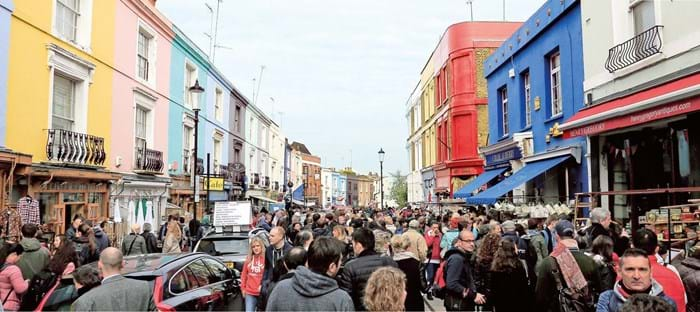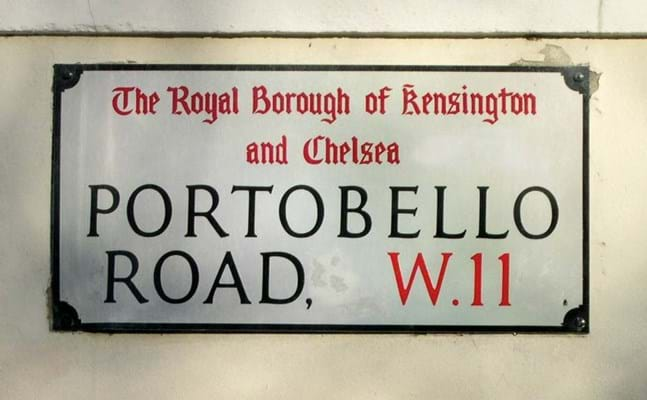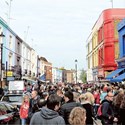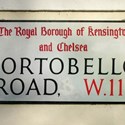For more than a decade many of the dealers of Portobello Road Market have warned of its imminent decline.
The dominance of antiques shops and stalls in the neighbourhood began to dilute in the first half of the 1990s, just as property developer Warren Todd began acquiring many of the area’s traditional arcades, letting spaces to retailers and tourist souvenir sellers.
Ryan Todd of landlord the Portobello Group (and the son of Warren) defends the quarter’s changing face.
“Since the film Notting Hill was released in 1999, many tourists want to wander around and you could argue the tourist trinket sellers serve a purpose – selling what many tourists want.”
Packed street
When ATG visited on a spring Saturday, the street was packed with visitors, forcing shoppers to progress at a snail’s pace along the west London thoroughfare.
“Here is the greatest number of antiques dealers in the UK coming together on a weekly basis,” says Costas Kleanthous, chairman of the Portobello Antiques Dealers Association (PADA), as he guides ATG down the famous road. “But it is difficult to catch shoppers who see tourist tat as they walk down the street. How do we draw them in?”
He says there are still more than 400 dealers in the area, down from perhaps a thousand a decade ago. But for the average visitor, these 400 or so antiques specialists are hard to spot.
The sellers of tourist souvenirs have prime position with stalls facing directly onto the street, past which an estimated 65,000 people file on an average Saturday.
Antiques traders
These sellers are able to pay higher rent as they often trade for several days a week, compared with just one or two for the antiques dealers.
Inside each cavernous arcade, hidden away from the casual visitor, sit the antique dealers, waiting patiently. “Some people think we sell just bric-a-brac,” says Meissen porcelain dealer Alexandra Alfandary, who runs a shop on the road. “But actually we have some very good dealers selling important, quality goods, a fact that needs to be realised once more and promoted.”
Younger influence

European sculpture and works of art dealer Matthew Holder.
A younger generation of traders is up for the challenge. At 25, Matthew Holder is one of the youngest members of LAPADA and BADA and has been trading from Portobello since 2011.
Although he is concerned about the sheer number of tourists who “clog up” the street and could “put off the serious buyers”, he warns that dealers shouldn’t “keep talking the road down”.
Selling early European sculpture and works of art with a focus on Gothic and Renaissance, he recognises the support fellow dealers provide to each other at Portobello. “It is a great community and is always friendly,” he says.
Worldwide visitors
Third-generation Portobello dealer Kitty Verity, specialising in antique and vintage jewellery, is confident there is a future for the street, partly because it draws “visitors from all over the world”.
But she, like Holder, is concerned about the “self-fulfilling prophecy” of the trade’s pessimism about its place in the neighbourhood. Happily there are reasons to be cheerful too, as the street still offers an accessible rung on the antiques trading ladder.
Family of dealers
“People can start out by having a full-time job and just take a stall at the weekend,” says Anna Kleanthous, who hails from a family of dealers. Her parents run Kleanthous Antiques with her uncle Costas, of PADA fame.
Anna is hopeful the younger generation will keep the street alive. The age range of dealers “is a real mixture: from 20 to 80 years old. It is multi-generational. There are great interactions between the generations and we learn from each other”.
Spending power
The average cost to take space on an external pitch of an arcade on a Saturday is around £225. Data from the Royal Borough of Kensington and Chelsea proves the area continues to be known as an antiques hub. Results from a yet-to-be-published visitor study found that antiques drive 15% of visitors, who account for 59% of aggregate spend.
“Antiques have been an important part of the market since the 1940s,” a council spokesman says.
“The market is always evolving. Many dealers are very successful even in the current challenging retail climate, and they will very likely form part of Portobello’s diverse and vibrant future.”
Costas Kleanthous argues that many of the dealers who quit Portobello “were the weaker ones. Those left are strong and have so much knowledge”.
What can be done to get the word out that Portobello remains an important antiques hub? Many of the Portobello dealers work throughout the week promoting their businesses – whether at fairs or via social media platform Instagram.
Portobello Group, for its part, is planning a new marketing strategy to help promote the street and is working up a five-year plan to ensure its success.
But the property company has other issues to deal with: costs are rising and although it did not pass on the recent 50% increase in business rates this year, it has to make commercial decisions.
“We stomached that burden of rates increases but if there are empty spaces we have to fill them, otherwise we would have to put the rents up,” Ryan Todd says.
Plans to increase trading for traditional antiques dealers from a Saturday to Thursday-to-Sunday is the next challenge. Todd believes more dealers will come around to this idea because the “younger generation is more flexible”.
“We seek a bright future for the independent retailers of this idiosyncratic street,” he says. “There’s a future for antiques but this will depend on the demand from dealers and their flexibility.”
Portobello Road Market continues to evolve but as long as the new generation of dealers follows through on its promise to fight for a place in the neighbourhood, antiques will remain at its heart for many more years to come.
Portobello Market timeline
1860s
The market began when the area developed after the opening of the Metropolitan Railway’s Notting Hill (now Ladbroke Grove) station in 1864.
1870s
Market traders known as ‘costermongers’ sold fresh fruit and vegetables brought from wholesale markets at Covent Garden, Billingsgate and Smithfield.
1920s
Discharged First World War soldiers and sailors sought to earn a living by trading. Second-hand clothes, shoes and ornament stalls began to appear alongside the traditional food stalls.
1940s
Antiques started to appear when dealers needed to find a new home after Islington’s Caledonian Market closed.
Source: Royal Borough of Kensington and Chelsea





















